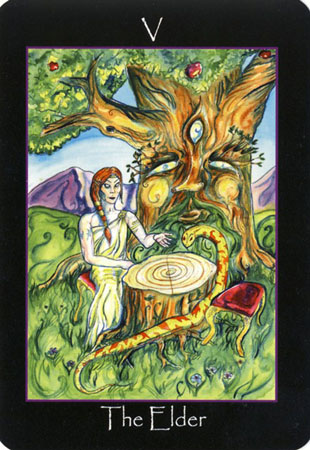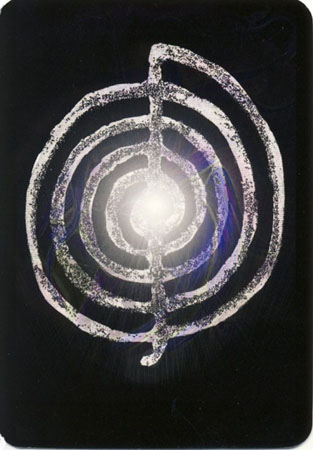
Some extraordinary new tarot decks have been published in the past few years. But just when you think it’s all been done, and that your brain will explode if you see another RWS clone, something truly new and unique appears and takes your breath away.
Tarot of the Sidhe is drawn from the inner world and imagination of Emily Carding, the artist who created the Transparent Tarot and the Transparent Oracle decks. The Sidhe (pronounced “shee”) or the Fae are denizens of a world separate from ours, yet offer their wisdom to us. The beings portrayed in the deck are an extension of the marvelous supernatural environment that they inhabit. The environment participates and co-creates the card meanings with the figures by contributing to the dynamic colors and textures of the deck.
The Elder (aka Hierophant) is a figure that isn’t male or female, old or young. Teachers and spiritual advisors can appear in any shape, size and gender. The Sidhe sits before a sentient tree with three eyes – it can probably read your aura. A tree stump with rings acts as a setting for the ubiquitous Great Glyph of the Sidhe that graces the card backs and appears throughout the deck. Here it tells time backwards and forwards. An empty seat sits across from the figure. Do you wish to sit and learn? Share wisdom? Have a cup of tea in the great outdoors? Teaching, learning and wisdom flow in all directions, and offer a multitude of possibilities.
The Major Arcana cards are fraught with events, meetings, and possibilities in the Sidhe’s alternate dimension. Characters gesture, offer, tease and stare. In The Wheel of Fortune, the three sisters of Fate are posed across the landscape. The nearest offers a basket of fruits, the one in the middle stirs a cauldron, and the one on the horizon summons lightning from the sky. Perhaps she’s opening a portal between the worlds. Something is about to change. One of the trees along the horizon is being struck by a bolt of lightning. Something is being torn apart. Or perhaps something in the first sister’s basket is being offered, something new and wonderful.
Carding shifts the Minor Arcana suit names to enhance her themes: Swords are Dreamers (Air), Wands are Warriors (Fire),Cups are Dancers (Water), and Pentacles are Makers (Earth). Each numbered suit card 2 through 10 has a descriptive subtitle printed at the bottom of the card. The suit cards are generally on track with traditional divinatory meanings, but Carding’s approach to imagery and meaning is a few light years outside of the box and jettisons the reader into uncharted and unexplored T-space.
The deck’s images are deeply entwined with the meanings given in the accompanying mini-book. While many great artist and writer teams have created worthy tarots, a book written by the artist offers a special kind of intimacy. Major Arcana card descriptions begin with a first-person monologue that narrates what is happening in the scene. This is followed by a few keywords and the artist’s insights - her remarks about how the card was created, some inside scoops and reflections. Minor Arcana cards receive a unique treatment: each card is described by a four-line poem, followed by keywords. The poems offer a greater scope of meaning than one might expect, and have multi-purpose potential for use in spell work, affirmations, writing prompts, and inner illumination. The more I work with these, the more I like them. The poems can be combined when Minor Arcana cards appear together to enhance the story-telling aspect of the cards.
For example, the poem-charm for the Maker Five card (5 of Pentacles), subtitled “Winter’s Bite,” reads:
Seasons come and seasons go,
Much is lost when harsh winds blow,
And in the midst of winter’s sting,
The Maker has forgotten spring…
Keywords are temporary loss, need, dejection, poverty, debt, casting off. The tree-woman depicted in the card is losing all of her leaves, and the wind scatters them all around here. The snow-covered landscape is bleak and cold, sharp mountains loom in the background. Overhead the clouds are thick and murky. But light rises from behind the mountains – all is not lost. The poem emphasizes the transitory nature of the situation, the need to be flexible when times are tough, and to remember that things will get better – spring will come in due time.
One of the most remarkable aspects of this deck is the artist’s process. Creating the deck was a spiritual journey and an act of service for the Sidhe, and the project was accomplished in a year and a day. Each card was drawn and painted spontaneously, with no planning sketches or deliberate content. Carding’s implicit trust in her Sidhe muses and intuition generated a deck that has much to offer to the open, questing mind. The untamed spontaneity of the artwork succeeds in opening William Blake’s doors of perception in unimaginable ways.
If your intuition is feeling a bit soggy, if you’re looking for a deck with an otherworldly, innovative approach, or if you’re a fantasy world or faerie lover (I believe in faeries!), put this on your tarot-to get list today.
~review by Elizabeth Hazel
Author: Emily Carding
Schiffer Publishing, 2010
$24.99
http://www.schifferbooks.com




